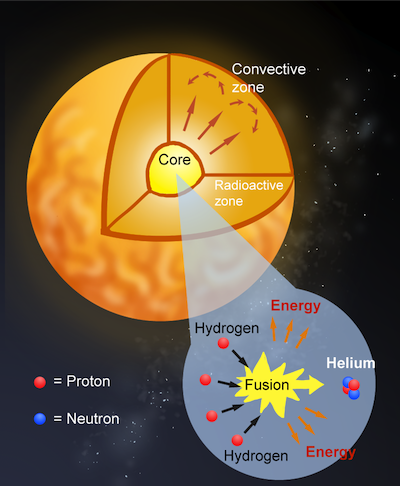Basic Nuclear Chemistry Reactions
So far, we've observed reactions that involve the rearrangement of atoms and the making and breaking of bonds. These types of reactions are classified as chemical reactions. There is another important type of reaction that doesn't fit into the previous category. The reactions that involve changes within the nucleus of atoms are called nuclear reactions.

Nuclear reactions occur inside an atom's nucleus.
Whether you realized it or not, we've all had some sort of exposure to nuclear reactions. We know that nuclear weapons are capable of horrific mass destruction. Most of us probably know someone that has undergone radiation therapy to help fight cancer. Even smoke detectors function at the mercy of a nuclear reaction. Crazy, huh? Because radioactivity and nuclear reactions are all around us, it's important to understand what's actually occurring, how it is happening, and how we can make it as safe as possible.

Smoke detectors function because of nuclear reactions. (Image from here.)
There are three types of radioactive decay: 1) alpha particle emission, 2) beta particle emission, and 3) gamma radiation emission.
Alpha Decay
Alpha decay, also known as alpha (α) particle emission involves the loss of one alpha particle from a nucleus of an atom. What's an alpha particle? An alpha particle is the same thing as a helium nucleus; it has two protons and two neutrons. Since it has no electrons it has a charge of +2. The way chemists short hand an alpha particle is the following: 42He. The four in superscripts is the mass number of the particle. The two in subscript is the atomic number.

An alpha particle: two protons and two neutrons. (Image from here.)
Here's a simple example of a radium atom emitting an alpha particle:

We picked the element symbols based on the atomic number of the products. Note that the sum of the mass numbers on the right (222 + 4) equals the mass that we started out with (226). Also, the same is true for the atomic numbers, which have a total of 88 on both sides. Do you know what this means? We have a properly balanced nuclear equation. Booyah.
Beta Decay
Beta (β) decay occurs when an atom emits a beta particle, which is also known as an electron. Beta particles are tiny and have a mass of almost zero, but they do have a -1 charge. The representation we use for a beta particle is 0-1e.

Beta Particles = Electrons
A common beta decay occurrence is the emission of an electron from a tritium atom (hydrogen-3):

Again notice the total mass and atomic number are equal on both sides of the reaction arrow. Always make sure your equations are balanced.
Gamma Radiation
Gamma (γ) radiation is high-energy electromagnetic radiation that often accompanies alpha or beta particle emission. This crazy radiation particle has no mass nor does it have charge, that's why it's represented by the simple symbol of 00γ, although sometimes the zeros are omitted. Don't let that trip you up.
Since the gamma particle has no charge and no mass it seems a bit silly to add it to our nuclear equations, but this type of emission actually does occur. When a nucleus emits an alpha or beta particle the nucleus is sometimes left in a high-energy unstable state. The nucleus can then "relax" to a more stable state by emitting a gamma particle.
Here's an example:

We hope you've enjoyed your brief introduction to nuclear chemistry. If you'd like to learn a little more check out here or here. The second link will guide you through the amazing nuclear chemistry of the sun. Or, you can watch this cool, but somewhat lengthy, video.